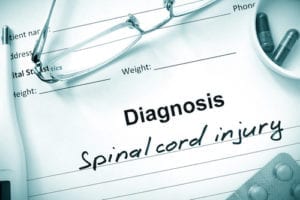Spinal cord injuries can be extremely dangerous, and seniors are at a higher risk than the general population. The Mayo Clinic notes that being over the age of 65 is a risk factor for spinal cord injuries.
A spinal cord injury can prevent the brain from communicating with other parts of the body. This can lead to long-term or permanent health issues.
Spinal cord injuries can cause:
- Partial or total paralysis
- Breathing, lung and respiratory issues
- Loss of bowel control
- Other health complications


Seniors are at an especially high risk of spinal cord injuries because they are more likely to fall. For seniors in nursing homes, spinal cord injuries are still a threat even when staff members are present.
If staff members don’t check up on their residents regularly, a spinal cord injury could be left untreated for long periods of time.
Nursing home administrators and staff members are using fall prevention programs and training to reduce the risk of injuries among residents. Doctors, nurses and scientists are also investigating how to better identify and treat spinal cord injuries in seniors.
Why Are Seniors at Risk of Spinal Cord Injuries?
The main cause of spinal cord injuries among seniors is falling. According to a 2017 study, around 60% of spinal cord injuries among older people are caused by falls.
Since seniors’ bodies are typically more fragile, it makes it easier for a fall to cause devastating injuries and harder for them to recover.
The Centers for Disease Control and Prevention (CDC) notes that more than 1 in 4 adults over the age of 65 fall each year.
Spinal Cord Injuries and Nursing Homes
Seniors living in nursing home facilities may be at risk for spinal cord injuries for a few different reasons.
Seniors in nursing homes can suffer a spinal cord injury if:
- They trip or fall during everyday activities (such as walking, getting out of bed or taking a shower)
- A staff member drops them as they are being transported
- An abusive staff member pushes them onto a floor
- Staff members do not give the resident equipment to help them move or stand
- Floors in rooms or hallways are not cleared of clutter and debris
Since seniors in nursing home facilities may need assistance getting from place to place, the burden of care lies on the staff and nurses. If staff members are neglectful or abusive, they may be partly responsible if the senior has suffered a spinal cord injury.
Complications Caused by Spinal Cord Injuries
Spinal cord injuries can lead to other health issues depending on how bad the injury is.
Spinal cord injuries can cause:
- Difficulty breathing and respiratory issues
- Paralysis of arms, legs and/or other body parts
- Partial or total loss of feeling
- Issues with coordination
- Loss of control over bowel movements
While some patients may be able to recover from a mild spinal cord injury over time, others may never be able to recover. Complications from a long-term or permanent injury can cause an older patient’s health to deteriorate.
For example, respiratory illnesses caused by spinal cord injuries are very risky. The Shepherd Center, a spinal cord hospital in Georgia, notes that pneumonia is the most common cause of death for anyone with a spinal cord injury.
Spinal Cord Injuries and Brain Injuries
Much like a traumatic brain injury or concussion, spinal cord injuries directly affect the brain’s control over major body functions. Seniors are at an especially high risk when spinal cord injuries and brain injuries occur together.
The brain and the spinal column work to control movements and sensations. When either is injured, this signal flow gets interrupted and leads to long-term or permanent impairment.
Among seniors, both brain and the spinal column injuries share a common cause: falling. For example, a senior can injure their head and their back during a fall. They also can share similar symptoms (such as loss of coordination and numbness in limbs).
Because of these factors, traumatic brain injuries may not be noticed at first by nursing home staff members or even doctors. In a 2014 study of patients with both traumatic brain and spinal cord injuries, 58% of brain injuries were missed in the initial diagnosis.
Because of this, nursing home staff members and doctors need to monitor their patients very carefully to make sure they have not also suffered a traumatic brain injury.
Life Expectancy for Spinal Cord Injuries
The life expectancy of patients with a spinal cord injury depends on how badly the patient was harmed.
Among seniors, the biggest health concern regarding spinal cord injuries is a higher risk of death. Older people may have a harder time recovering from spinal cord injuries as their bodies are typically weaker, and complications (such as pneumonia) can cause them to die.
That being said, the long-term outlook is pretty positive.
According to the Shepherd Center, 85% of patients who suffer a spinal cord injury will still be alive 10 years later if they survive the first 24 hours.
This statistic reinforces the need for proper supervision in nursing homes. If the patient suffers a spinal cord injury and is not properly attended to, they could miss this 24-hour window.
Trends in Spinal Cord Injuries
Research notes that spinal cord injuries among seniors have increased over the last 20 years.
A recent study noted that:
- In the 1990s, 28% of elderly people suffered fall-related spinal cord injuries
- In the 2010s, this number jumped to 66%
Global trends also backed up these findings. The study noted that there were 84 injuries per million seniors in 1993. In 2012, that number jumped to 131 cases per million seniors.
Researchers could not determine specifically why the risk increased. However, seniors today are more active than they were in the 1990s, and they suspect that this plays a role. More physical activity could make falls — and spinal cord injuries — more likely.
Spinal Cord Injury Prevention
Preventing seniors from falling will play an important role in reducing the number of spinal cord injuries, since falls are the leading cause of these injuries.
Some preventative steps may include:
- Rehabilitation efforts to improve mobility and stability
- Education about the risk of spinal cord injuries
These efforts can be undertaken not only by nursing home staff but also the family members and loved ones of residents.
If possible, family members should also check up regularly on family members living in nursing homes. This will allow them to better monitor their loved one’s health and note any problems that may appear.
Medical resources are also focusing their attention toward helping those affected by spinal cord injuries. As noted in recent studies, the National Institute of Health set aside $86 million for research on spinal cord injuries.
By expanding research and awareness, spinal cord injuries can hopefully be better treated and prevented.
Next Steps for Seniors with Spinal Cord Injuries
If you or a loved one suffered a serious spinal cord injury in a nursing home, it can be devastating both emotionally and financially. The cost of medical care for a spinal cord injury can be extremely expensive — and unexpected.
Nursing home staff members have a duty to keep their residents safe. When they fail to do so, they may be responsible for your loved one’s injuries.
Fortunately, you have legal options that can help you receive financial compensation. Compensation can help you pay for the medical treatment your loved one needs and hold the staff responsible for the damage they have done.
To learn more about spinal cord injuries and your legal options, call (877) 437-6288 or fill out the contact form today.

